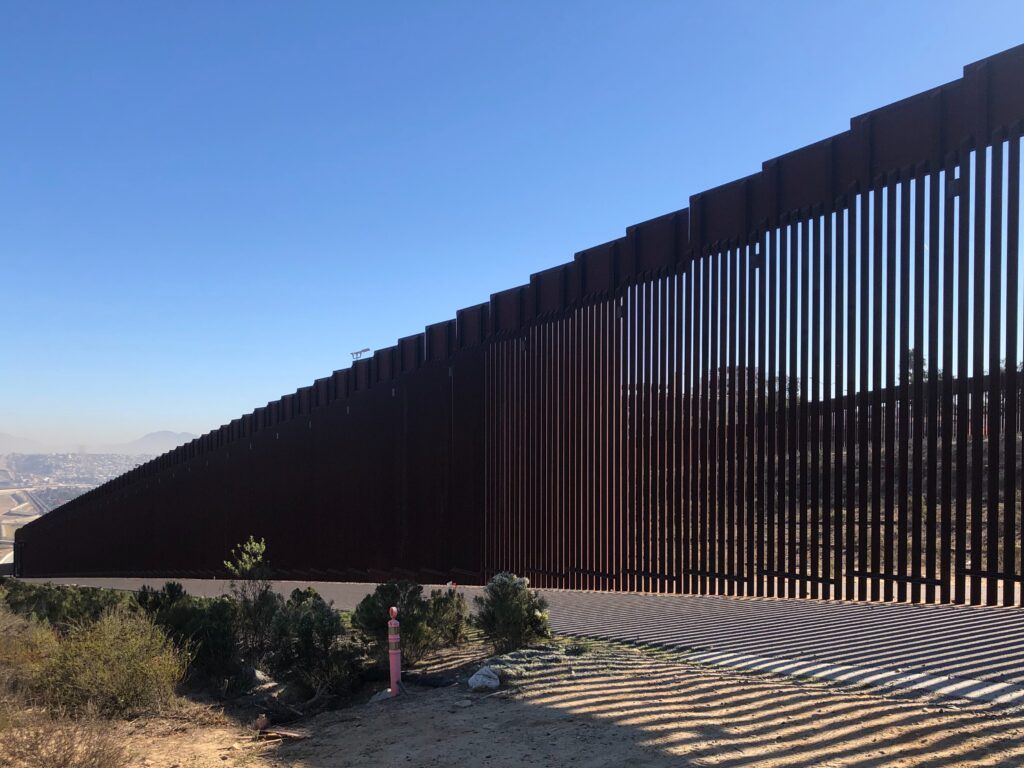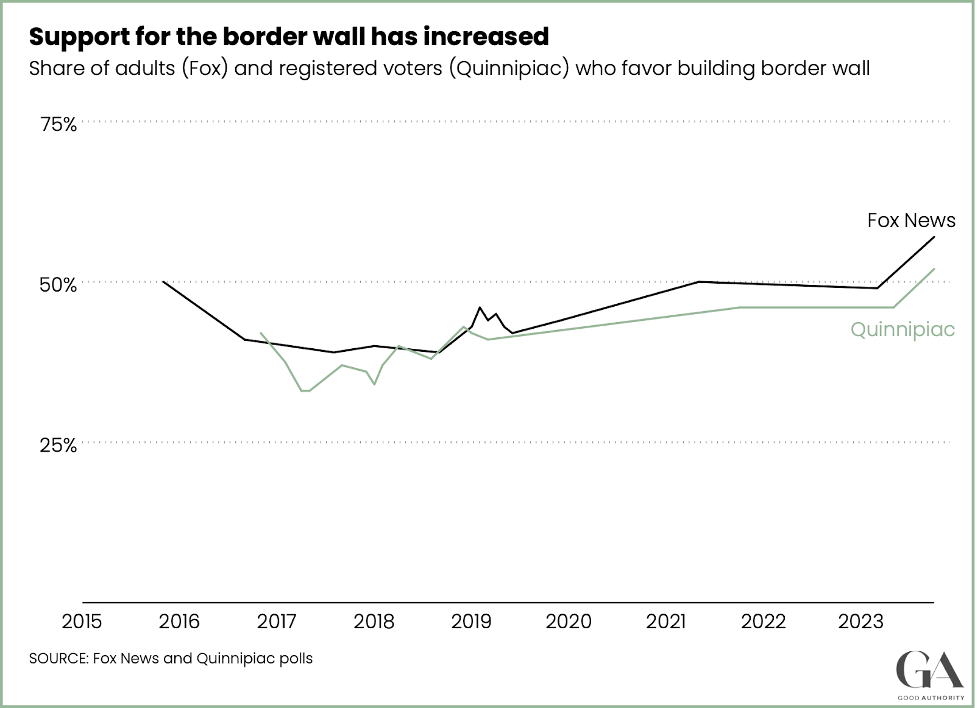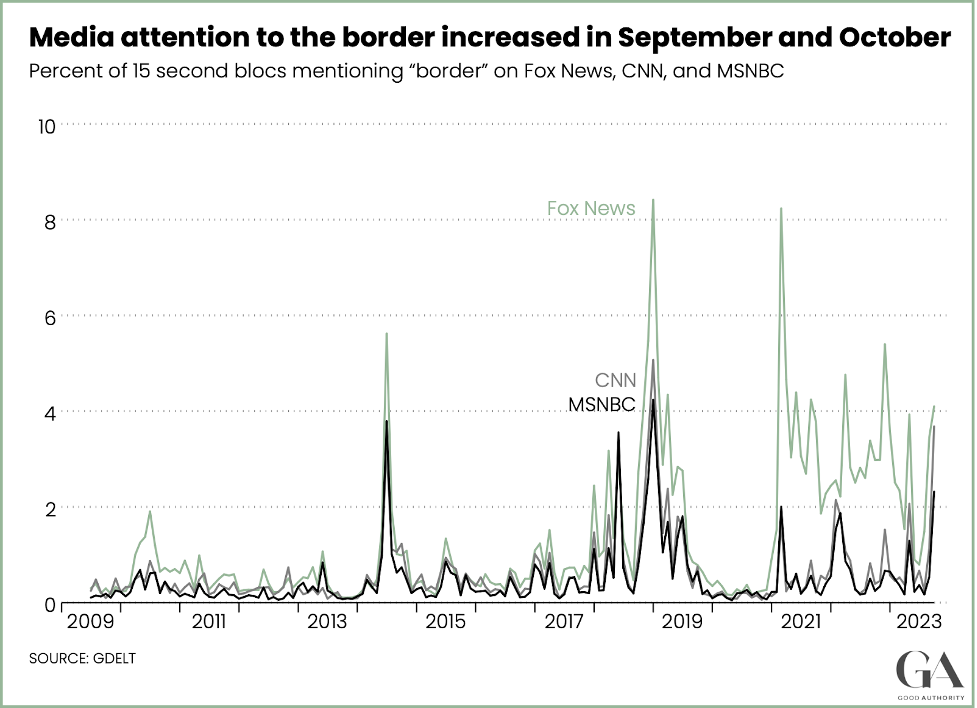
Public support for building a wall along the U.S.-Mexico border recently reached new heights in tracking surveys from both Quinnipiac University and Fox News.
You can see in the figure below that the share of adults who favor the wall increased to 57% in the October 6-9 Fox News Poll, surpassing prior highs of 50% in November 2015 and May 2021. The figure further shows that the 52% of registered voters who supported building the wall in Quinnipiac’s October 12-16 survey was a higher figure than the university pollster’s previous highs of 46% in both October 2021 and May 2023.

Immigration as a “thermostatic” issue
These data points are the latest evidence of a broader pendulum shift back to the right in public opinion about immigration during Biden’s presidency.
Americans in general, and Democrats in particular, moved sharply to the left on several questions about race, ethnicity, and immigration in response to Donald Trump’s harsh rhetoric during his 2016 presidential campaign and subsequent presidency. Those progressive shifts included declines in support for the border wall shown in both the figure above and in data from several additional pollsters.
But when Trump left the White House in January 2021, the political scrutiny soon shifted to the Biden administration’s less-restrictive immigration policies. Public opinion quickly followed suit, as support for decreasing immigration levels, deporting deporting undocumented immigrants, and building the border wall all rose in the first few months of Biden’s presidency.
On the one hand, this trend fits within a familiar pattern in political science research arguing that public opinion often operates as a “thermostat,” whereby the public shifts against the current president’s positions to prevent policymaking from becoming too liberal or too conservative. For example, Americans’ support for universal government health insurance dropped during Obama’s presidency and then increased as the Trump administration tried to repeal the Affordable Care Act in 2017.
These recent pendulum swings on immigration, however, mark a potentially noteworthy departure. Thermostatic trends in Americans’ views about race and ethnicity have historically been weaker than Americans’ reactions to presidents’ economic policies.
But that was before immigration became such a deep dividing line between Democrats and Republicans. Now, with the two parties pushing harder in opposite directions on immigration than they have in the recent past, the public is increasingly pushing back on the president’s policies – just like a thermostat.
Short-term focus on the southern border
This long-term thermostatic trend in immigration attitudes, however, still can’t explain why support for the wall was higher in October than it had been in prior 2023 surveys conducted by both Fox News and Quinnipiac University. The recent surge in support probably stems, instead, from the renewed media attention to the southern border in September and early October.

Drawing on GDELT data, the graph above shows that even Fox News didn’t pay much attention to the southern border in June and July. But Fox, MSNBC, and CNN all devoted considerable attention to it during the first week of October. So much so, that MSNBC and CNN mentioned the border at a higher rate in early October than they had in any month since the government shutdown in January 2019 over funding for the border wall. (Note: The analysis ends on Oct. 6, 2023, due to the sharp increase in mentions of the Gaza-Israel border after Oct. 7).
The news stories behind the growing media attention in early October included headlines such as “Migrants Arrive in Record Numbers at the US-Mexico Border” and “Biden to Build More Border Wall Using Trump-Era Funds.” These types of stories likely helped push support for the wall to record levels by increasing concerns about border security and creating some semblance of bipartisan support from the past two presidents for erecting the barrier.
That would certainly be consistent with John Zaller’s prominent theory of public opinion, which argues that people express opinions based on easily accessible information. In this model, the impact of media attention to border crossings on public opinion should persist only so long as it is at the forefront of the public’s collective mind.
The high levels of support for the border wall registered in October surveys will most likely decline a bit, then, if/when the media’s attention to the U.S.-Mexico border recedes – and the headlines decrease.



